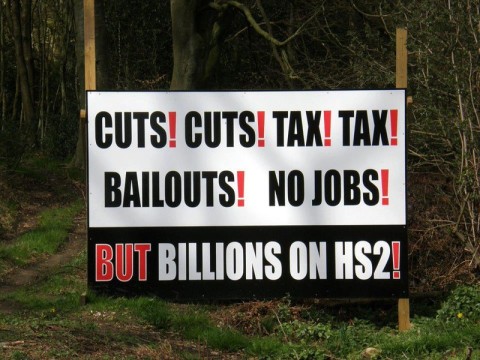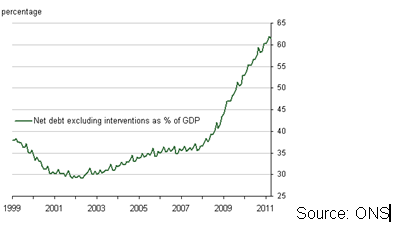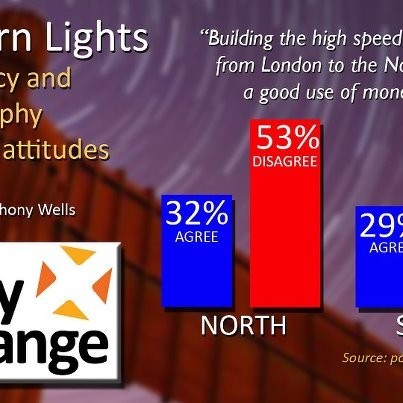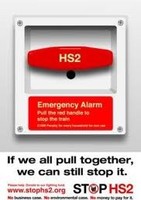The case against High Speed Rail (HS2) - Business
Recent article in Moneyweek: HS2 a disaster in the making:
http://www.moneyweek.com/blog/hs2-a-disaster-in-the-making-62500#.USPdCAzWRhA.email
DAVID CAMERON SAYS THERE IS NO MAGIC MONEY TREE (but evidently there IS enough money to pay for HS2 - while closing both London Borough of Ealing's A&E hospital services at Ealing Hospital and Central Middlesex Hospital):
BUSINESS CASE AGAINST HS2
On 13th September 2011 Philip Hammond, then SoS for Transport said to the Transport Select Committee on HS2: ‘If it [the Benefit Cost Ratio (BCR) of HS2] were to fall much below 1.5, I would certainly be putting it under some very close scrutiny’
On 11th April 2012 the Guardian stated: ‘The latest figures issued by HS2 have revised down the economic benefits for the fourth time, suggesting that the scheme will barely, if
ever, break even. Originally forecast to bring £2.40 of benefits for every pound invested, the revised BCR is 1.2 – 1’
As outlined in the Capacity section the BCR is likely to fall even further and will eventually be 0.3 - i.e. a return of just 30p on every £1 invested from the public purse.
From a Freedom of Information request that the Department for Transport’s own 170 page Reference Work entitled: ‘Productive Use of Rail Travel Time and the Valuation of Travel Time Savings for Rail Business Travellers’ - Final Report June 2009 - states that:
‘a reduction in scheduled rail journey time for a business traveler by, for example 10 minutes, would increase the average amount of time spent working by all business travelers by just 0.75 minute’
indicating that there is 'economic benefit' in just 7.5% of the time saved by business travelers. However, the HS2 business case also produced by the Department for Transport claims economic benefit for 100% of the time saved by business travelers. This appears to be a huge difference and contradiction.
Moreover Network Rail's recommendation in this same repor to reduce the value used for business travelers by 50% from 7.5% to 3.7% of the time saved, was ignored instead
values the Department for Transport describe as 'unsupportable' have been used in the HS2 business case:
‘if these new values were carried through to forecast values using the current methodology these would reduce the estimated benefits of speeding up the current rail system to this segment of
business passengers by around 50%, changing from a figure of £0.74 per minute saved at 2008 prices as reported in WebTAG to £0.37 per minute saved, as a basis for quantifying benefits at current
values before allowing for income changes over the forecasting period. This difference arises from switching from a theoretical value for time savings (based on premises which we have shown to be
unsupportable) to an empirical value based on observation.’
The report found that up to 82% of business travelers did some work on train journeys and almost half of all train travel time by businesspeople was spent working. It also found that most business travelers would not do any extra work off the train in the time that they had ‘saved’ through a faster journey, stating:
‘A reduction in journey time does not lead to much extra productive time overall… Sixty per cent [of business travelers] reported that they would do no work in the 'saved' time.’
In relation to the ‘Productive Use of Rail Travel Time and the Valuation of Travel Time Savings for Rail Business Travellers’ it has also come to light that one senior official at the DfT explicitly told colleagues that this report could not be used or published because it would spoil the case for HS2.
BELOW - embarrassment for The Department for Transport when, after questioning from the Public Accounts Committee and its chair, Margaret Hodge, are forced to reveal that HS2 has been given an Amber-Red warning.
It must be asked now why the government is proposing to spend what will eventually be in the region of £50 to 100 billion on HS2, once rolling stock, passenger dispersal, interest on borrowing to fund HS2 and other costs are incorporated, to bring a few minutes journey time savings to 0.1% of the population, when our national debt is already £988.7 billion, there are 2.87 million unemployed and our public sector is being cut left right and centre? Indeed if all financial sector intervention is included (including the Royal Bank of Scotland and Lloyds), the Net debt is £2311.6 billion (147.3% of GDP).
NORTH SOUTH DIVIDE
There is debate about whether a ‘North South divide’ exists at all, and if so how it might be delineated geographically. Professor Peter Mackie, of Leeds University Institute for Transport Studies, is an eminent transport economist and has been a key advisor to HS2 Ltd, sitting on their Analytical Challenge Panel. In his written evidence to the Transport Select Committee he stated: ‘For various reasons, HS2 is rather unlikely to make much difference to the North -South divide. A spatial analysis would probably show London to be the main benefitting region. … claims of ‘strategic value’ need to be 'capable of interrogation.’ Last year the consultants Steer-Davies-Gleave produced a report for “The Northern Way” (a development partnership between northern cities). That report revealed that the top 3 "absolutely essential" factors for locating a business were:
1. Availability of qualified staff
2. Easy access to markets, customers or clients
3. The quality of telecommunications
4. Transport connections with other cities and internationally
Transport only came fourth. However the source of that information has since been updated and it now reveals that the gap between telecoms and transport has grown. Steer-Davies-Gleave also referred to a report to the Department for Transport from NERA Economic Consulting which investigated the extent to which domestic transport interventions may materially affect international business. The report admitted:
‘That study found little empirical research to quantify the impacts of transport on international trade and foreign direct investment and concluded that further primary research was needed in this area. It also found it difficult to establish causal links that either transport infrastructure provides trade, or trade provides the need for more transport infrastructure.’
As for London, it already has fantastic transport links with several airports and rail links. But despite these apparent advantages, the latest ONS Labour Market Statistics show that unemployment in London (at 9%) is higher than the West Midlands (8.8%), and the North West (8.1%) and equivalent to Yorkshire (9%). In fact ONS statistics also show that since 2006, regional unemployment in the West Midlands, the North West, and Yorkshire (the proposed HS2 regions) has very often been lower than the London unemployment.
What HS2 may in serious danger of doing in fact is driving more investment away from the West Midlands and North and towards an overcrowded central London.









